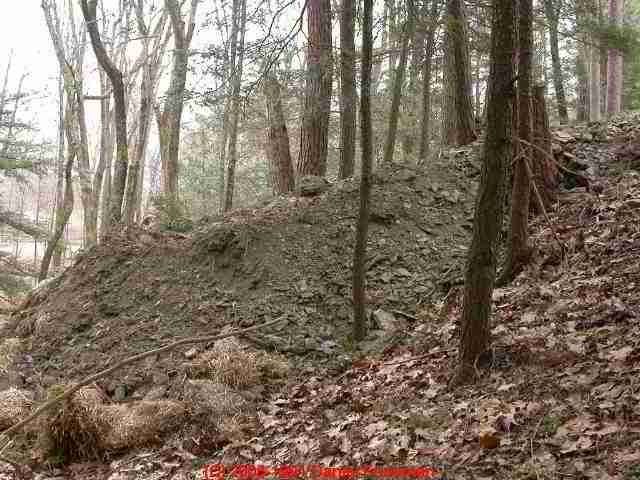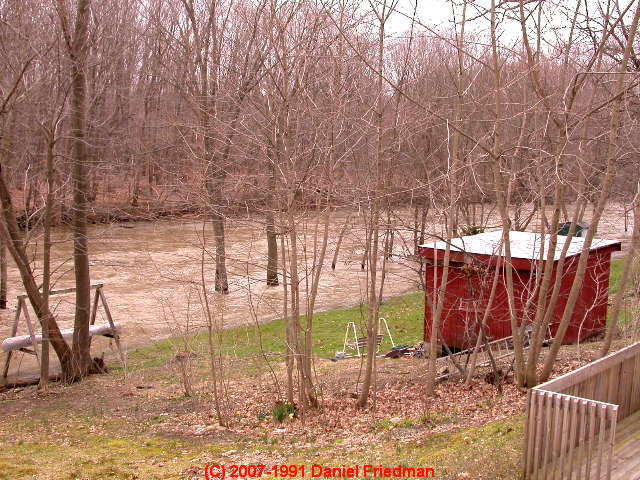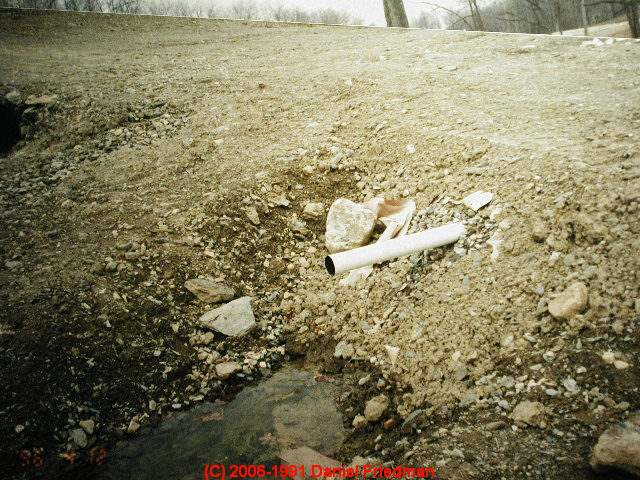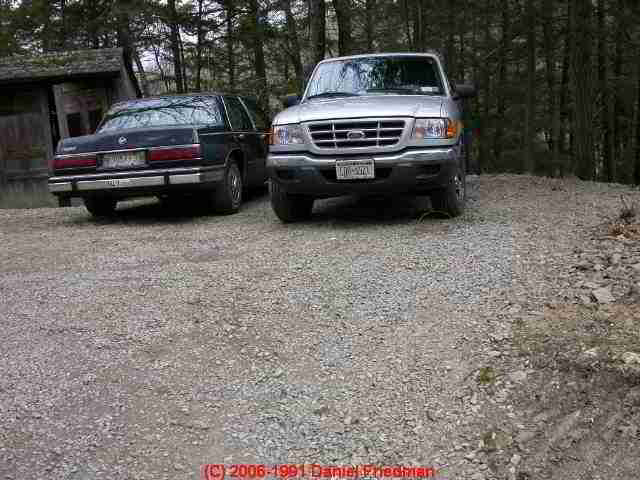 Inspecting Difficult Septic System Sites: steep, lakeside, rocky
Inspecting Difficult Septic System Sites: steep, lakeside, rocky
- POST a QUESTION or COMMENT about recognizing & inspecting sites where installation of a septic tank and drainfield will be difficult or impossible
Difficult site septic systems design, inspection, repair: this document describes how to look for visual evidence of septic failure without or before testing a septic system and also difficult site conditions that may require special measures to install a working septic system.
InspectAPedia tolerates no conflicts of interest. We have no relationship with advertisers, products, or services discussed at this website.
- Daniel Friedman, Publisher/Editor/Author - See WHO ARE WE?
How to Inspect DIFFICULT SEPTIC SITES - Indicators of Difficult Septic Installation Sites

Our page top photo shows a fresh pile of rock and soil pushed over the edge of a steep rocky embankment near where we understood a septic tank to be located.
Even before beginning our inspection we were concerned about what we might find since this was a difficult septic site.
Looking for these conditions can give key information about the condition of the septic system before (and perhaps without) performing a septic loading and dye test and also before (and perhaps without) invasive septic system inspection measures such as excavation.
Septic System Near a Stream exposed to flooding:
As shown in our photo just above, at homes along Wappingers Creek in Dutchess County, NY, many septic tanks and drainfields are close to the waterway. Seasonal flooding such as shown in this photo make drainfield floods likely.
Even when flood conditions are not present, some drainfields may be too close to the creek to comply with state building and health codes, and worse, the high water table near the creek may prevent such systems from adequately treating septic effluent before it is discharged into the environment.
Up-slope drainfields with effluent pumps or other special measures may be needed.
Septic Loading & Dye Tests for Properties Close to Rivers, Lakes, Streams, Ponds & Drainage Ditches
Dye tests of septic systems close to a lake or stream like this will sometimes discover that a property owner having a failing septic system succumbed to the temptation to simply run an effluent discharge line right from the end of a bad drainfield into the stream. Remember to look both above and below the water line for unexplained pipes in the area.
- Steep Slope or Steep Site Septic Systems:
If the building site is steep then special measures may have been needed to provide a working drainfield, or septic tank and field components may not be located near the building they serve and a pumping system may have been needed. Be on special alert for evidence of septic effluent breakout down-slope and at the bottom of steep slopes if septic components are nearby.
See STEEP SLOPE SEPTIC DESIGNS for details of how septic system need to be installed on steep or sloping sites in order to provide a working and durable drainfield. - Rocky Site Septic Systems:
if there is insufficient depth of soil, proper treatment of septic effluent may be impossible using a conventional septic tank and drainfield. At some sites including the one shown in our page top photo, there may be so little topsoil over bedrock that there is not depth for a conventional septic tank to be buried.
At such sites an installer may provide a "low boy" septic tank - one that obtains its volume by spreading over a larger footprint but with a shallow septic tank.
Shallow septic tanks may need special or more frequent pumping, and should be taken as an alert to inspect the D-box and drainfield carefully. A drainfield or soil absorption system needs (typically) about 2 ft. of soil below the bottom of the drainfield and the top of any nearby rock or high ground water.
So a drainfield installed in just a couple of feet of soil over bedrock is not going to perform well and may not be approved by local health officials.
Flat septic site near a lake:
The land shown in this photo was a new home site which not only had standing water, but had only a few feet
of elevation between the yard top grade and the top of the nearby lake also shown in the photo.

The pipe shown was a footing drain emptying at the edge of a nearby lake. The septic tank and drainfield were buried in this area. I couldn't imagine how a conventional
septic tank and drain field would work in this location.
Here is a photo of the septic tank being installed at this property. That downspout you see spilling by the foundation needs to be extended away from the home, but not where the roof drainage will simply enter the septic tank and flood the leach field.
Here is a photo of the end of the home footing drain, higher than where
the bottom of a leach field trench needs to go, and spilling into the lake.
Here is a photo of the contractor's "repair" of the exposed footing drain and minimal soil depth at the property.
I can't inform readers of what the building department ultimately had to say about this installation.

Vehicle areas near Septic Tanks or Fields: Is there evidence of driving or parking on the leachfield or over a tank? (Risks damaging the system or dangerous collapse.)
At the property shown in this photo, the truck is parked over a "low boy" septic tank which was installed over bedrock.
The rock pile shown at the top of this page was behind this truck and pushed over the embankment to cover a failed seepage pit - there was no working drainfield at this site.
Soil conditions before septic test start:
What are soil and site conditions before start of the test: are there wet areas, evidence of surface
discharge of effluent or sewage, green grassy or soft, suspect areas?
Odors? It is important to be able to record
these conditions and their extent before and after testing.
- Mound systems vs. original site:
Has the mound system been constructed over a natural surface drainage path or stream? Are trees and stumps sticking out of the mound (meaning it was used to bury site debris not to make a proper absorption field)?
These pages are part of our SEPTIC DYE TEST PROCEDURE for testing septic system function. Technical review by industry experts has been performed and is ongoing - reviewers are listed atReferences or Citations . Comments and suggestions for content are welcome.
...
Continue reading at RECENT SEPTIC WORK or select a topic from the closely-related articles below, or see the complete ARTICLE INDEX.
Suggested citation for this web page
DIFFICULT SEPTIC SITE DESIGNS at InspectApedia.com - online encyclopedia of building & environmental inspection, testing, diagnosis, repair, & problem prevention advice.
Or see this
INDEX to RELATED ARTICLES: ARTICLE INDEX to SEPTIC SYSTEMS
Or use the SEARCH BOX found below to Ask a Question or Search InspectApedia
Ask a Question or Search InspectApedia
Questions & answers or comments about septic systems installed on difficult, rocky, or steep sites
Try the search box just below, or if you prefer, post a question or comment in the Comments box below and we will respond promptly.
Search the InspectApedia website
Note: appearance of your Comment below may be delayed: if your comment contains an image, photograph, web link, or text that looks to the software as if it might be a web link, your posting will appear after it has been approved by a moderator. Apologies for the delay.
Only one image can be added per comment but you can post as many comments, and therefore images, as you like.
You will not receive a notification when a response to your question has been posted.
Please bookmark this page to make it easy for you to check back for our response.
IF above you see "Comment Form is loading comments..." then COMMENT BOX - countable.ca / bawkbox.com IS NOT WORKING.
In any case you are welcome to send an email directly to us at InspectApedia.com at editor@inspectApedia.com
We'll reply to you directly. Please help us help you by noting, in your email, the URL of the InspectApedia page where you wanted to comment.
Citations & References
In addition to any citations in the article above, a full list is available on request.
- New York State Department of Health, APPENDIX 75-A WASTEWATER TREATMENT STANDARDS - INDIVIDUAL HOUSEHOLD SYSTEMS [PDF] New York State Department of Health, 3 February 2010, retrieved 3/1/2010, original source: https://www.health.ny.gov/regulations/nycrr/title_10/part_75/appendix_75-a.htm
- Percolation Testing Manual [PDF] CNMI Division of Environmental Quality, Gualo Rai, Saipan provides an excellent English Language manual guide for soil percolation testing. Original source: www.deq.gov.mp/artdoc/Sec6art108ID255.pdf
- Soil Test Pit Preparation [PDF] fact sheet, Oregon DEQ Department of Environmental Quality, original source www.deq.state.or.us/wq/pubs/factsheets/onsite/testpitprep.pdf The Oregon DEQ onsite water quality program can be contacted at 811 South Ave, Portland OR 97204, 800-452-4011 or see http://www.oregon.gov/DEQ/
- Thanks to reader Michael Roth for technical link editing 6/29/09.
- SEPTIC TANK/SOIL-ABSORPTION SYSTEMS: HOW TO OPERATE & MAINTAIN [PDF] - , Equipment Tips, U.S. Department of Agriculture, 8271 1302, 7100 Engineering, 2300 Recreation, September 1982, web search 08/28/2010, original source: http://www.fs.fed.us/t-d/pubs/pdfimage/82711302.pdf.
- Onsite Wastewater Disposal, R. J. Perkins; Q
- Onsite Wastewater Treatment Systems, Bennette D. Burks, Mary Margaret Minnis, Hogarth House 1994 - one of the best septic system books around, suffering a bit from small fonts and a weak index. While it contains some material more technical than needed by homeowners, Burks/Minnis book on onsite wastewater treatment systems a very useful reference for both property owners and septic system designers.
- Septic Tank/Soil-Absorption Systems: How to Operate & Maintain [PDF] Equipment Tips, U.S. Department of Agriculture, 8271 1302, 7100 Engineering, 2300 Recreation, September 1982, web search 08/28/2010, original source: http://www.fs.fed.us/t-d/pubs/pdfimage/82711302.pdf
- Percolation Testing Manual, [PDF] CNMI Division of Environmental Quality, PO Box 501304, Saipan, MP 96950
- Planting Over Septic System Components [PDF] Daniel Friedman (author/editor, InspectAPedia.com), The Innovator, Winter/Spring 2008, BCOSSA, British Columbia OnSite Sewage Association, 201-3542 Blansard St., Victoria BC V8X 1W3 Canada
- Mark Cramer Inspection Services Mark Cramer, Tampa Florida, Mr. Cramer is a past president of ASHI, the American Society of Home Inspectors and is a Florida home inspector and home inspection educator. Mr. Cramer serves on the ASHI Home Inspection Standards. Contact Mark Cramer at: 727-595-4211 mark@BestTampaInspector.com
- John Cranor [Website: /www.house-whisperer.com ] is an ASHI member and a home inspector (The House Whisperer) is located in Glen Allen, VA 23060. He is also a contributor to InspectApedia.com in several technical areas such as plumbing and appliances (dryer vents). Contact Mr. Cranor at 804-873-8534 or by Email: johncranor@verizon.net
- US EPA ONSITE WASTEWATER TREATMENT SYSTEMS MANUAL [online copy, free] Top Reference: US EPA's Design Manual for Onsite Wastewater Treatment and Disposal, 1980, available from the US EPA, the US GPO Superintendent of Documents (Pueblo CO), and from the National Small Flows Clearinghouse. Original source http://www.epa.gov/ORD/NRMRL/Pubs/625R00008/625R00008.htm Onsite wastewater treatment and disposal systems, Richard J Otis, published by the US EPA. Although it's more than 20 years old, this book remains a useful reference for septic system designers. U.S. Environmental Protection Agency, Office of Water Program Operations; Office of Research and Development, Municipal Environmental Research Laboratory; (1980)
- "International Private Sewage Disposal Code," 1995, BOCA-708-799-2300, ICBO-310-699-0541, SBCCI 205-591-1853, available from those code associations.
- "Manual of Policy, Procedures, and Guidelines for Onsite Sewage Systems," Ontario Reg. 374/81, Part VII of the Environmental Protection Act (Canada), ISBN 0-7743-7303-2, Ministry of the Environment,135 St. Clair Ave. West, Toronto Ontario M4V 1P5 Canada $24. CDN.
- US HEW, MANUAL of SEPTIC TANK PRACTICE [PDF] 1975, U.S. Department of Health, Education and Welfare, Public Health Servicve, original source: https://nepis.epa.gov/
- Manual of Septic Tank Practice, US Public Health Service's 1957, reprinted in 1963, 1967, 1969 and in a 1975 edition given just above.
- Septic System Owner's Manual, Lloyd Kahn, Blair Allen, Julie Jones, Shelter Publications, 2000 $14.95 U.S. - easy to understand, well illustrated, one of the best practical references around on septic design basics including some advanced systems; a little short on safety and maintenance.
- Water Wells and Septic Systems Handbook, R. Dodge Woodson.
- Wells and Septic System, Alth, Max and Charlet, Rev. by S. Blackwell Duncan, $ 18.95; Tab Books 1992. We have found this text very useful for conventional well and septic systems design and maintenance --DF. Q
- Pennsylvania State Wastewater Treatment Fact Sheet SW-161, Septic System Failure: Diagnosis and Treatment
- Pennsylvania State Wastewater Treatment Fact Sheet SW-162, The Soil Media and the Percolation Test
- Pennsylvania State Wastewater Treatment Fact Sheet SW-l64, Mound Systems for Wastewater Treatment
- Pennsylvania State Wastewater Treatment Fact Sheet SW-165, Septic Tank-Soil Absorption Systems
- Document Sources used for this web page include but are not limited to: Agricultural Fact Sheet #SW-161 "Septic Tank Pumping," by Paul D. Robillard and Kelli S. Martin. Penn State College of Agriculture - Cooperative Extension, edited and annotated by Dan Friedman (Thanks: to Bob Mackey for proofreading the original source material.)
- The NSFC Products List has an excellent list of design manuals/modules National Small Flows Clearinghouse (NSFC) now (2019/12/13) hosted at http://www.nesc.wvu.edu/ Tel: 304-293-4191 e-mail info@mail.nesc.wvu.edu.
he National Small Flows Clearinghouse (NSFC) was funded by the U.S. Environmental Protection Agency (EPA) to help America's small communities and individuals solve their wastewater problems through objective information about onsite wastewater collection and treatment systems. NSFC products and information are the only national resource of its type, dealing with small community wastewater infrastructure. or by telephone 800-624-8301 - In addition to citations & references found in this article, see the research citations given at the end of the related articles found at our suggested
CONTINUE READING or RECOMMENDED ARTICLES.
- Carson, Dunlop & Associates Ltd., 120 Carlton Street Suite 407, Toronto ON M5A 4K2. Tel: (416) 964-9415 1-800-268-7070 Email: info@carsondunlop.com. Alan Carson is a past president of ASHI, the American Society of Home Inspectors.
Thanks to Alan Carson and Bob Dunlop, for permission for InspectAPedia to use text excerpts from The HOME REFERENCE BOOK - the Encyclopedia of Homes and to use illustrations from The ILLUSTRATED HOME .
Carson Dunlop Associates provides extensive home inspection education and report writing material. In gratitude we provide links to tsome Carson Dunlop Associates products and services.


